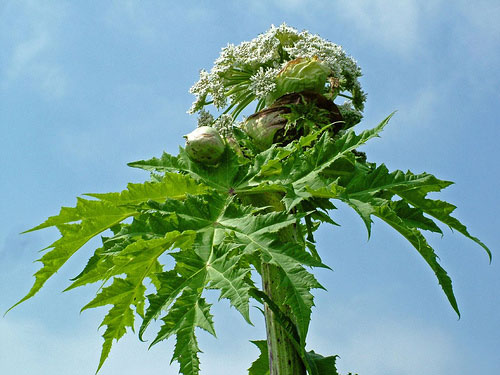Common
Hogweed
Heracleum
sphondylium
ID
Video
4 October 2017
Common
Hogweed
Heracleum
sphondylium
ID
Video
Hogweeds
compared
Buckingham
Cutting (south)
Common
Hogweed
Heracleum
sphondylium
Downs
Link Cyclepath between Erringham Gap and the fields south of Bramber
Common
Hogweed, Wild Carrot
The
micro-moth is Pammene
aurana
Adur
Levels
1 July 2016
Giant Hogweed
Still cloudy and overcast and too breezy for the open downs, I made a detour to Buckingham Cutting (south) where the Giant Hogweed had grown much higher than a person towering at least three metres above the path. It did not seem to be a week since I last visited but that was because of the intervening thunderstorms and rain.
13 August 2015
Hoverflies
and
Digger
Wasp Ectemnius sp
on
Common
Hogweed
Buckingham
Cutting (south)
Common Hogweed
| 18
June 2006
This looks like the Giant Hogweed, Heracleum mantegazzianum, towering above the other vegetation on the Malthouse Meadows, Sompting. It was over two metres (7 ft) high. |
 |
|
|
The largest of these hogweeds will grow up to over two metres height within six months in 2004.
June/July 2004
At a fraction over two metres high, I thought that this one was the Giant Hogweed, Heracleum mantegazzianum, at least one plant growing amongst the thistles. This huge alien plant can cause an untreatable and unpleasant rash on affected people. The ubiquitous Common Hogweed, Heracleum sphondylium, grows to a height of two metres in favourable conditions, although it is usually much smaller. The rash produced from the sap of the native umbellifer is not so harmful.
In favour of the identification of the Giant Hogweed is that these plants have reached this height in about six months. The Common Hogweed is thought to grow this fast, but at the time of writing, I have not found details of the growth rates on these two hogweeds.
The
hogweeds exude a clear watery sap which sensitizes the skin to ultraviolet
radiation. This can result in severe burns to the affected areas resulting
in severe blistering and painful dermatitis. These blisters can develop
into purplish or blackened scars.
Giant
Hogweed Information Page
It is giant hogweed.
The easiest distinguishing feature apart from
size is that it is much
less hairy. Ordinary hogweed is "hispid",
which means bristly-hairy,
whereas giant is described by Stace
as "softly pubescent", which
means slightly fuzzy. In practice it
looks hairless until you
get close. The shape of the leaf is
different too, as is the
general triffid-like appearance, with very
wide stems and huge stipules
covering the
unhatched flower heads.
It occurs not uncommonly
in patches along rivers, by roadsides and
on waste ground. I've
posted a photo
showing it in
very large quantities along
the upper Arun near Horsham (in 2001).
We have quite a few colonies
round here on the Hampshire/Dorset
border, and there used to
be (around 1990) one just south of the
entrance to the Sussex showground
at Ardingly. Spectacular to look
at, with irritant sap (makes
skin highly light-sensitive, like wild
parsnip), and in large quantities
it can smother natural vegetation.
According to Stace there
are hybrids of it with common hogweed, and
also apparently some plants
(differently-shaped fruits) may be a
slightly smaller related
species, Heracleum persicum. Yours is
probably mantegazzianum,
though it might be worth looking at the
fruits later.
Richard Collingridge on UK Botany